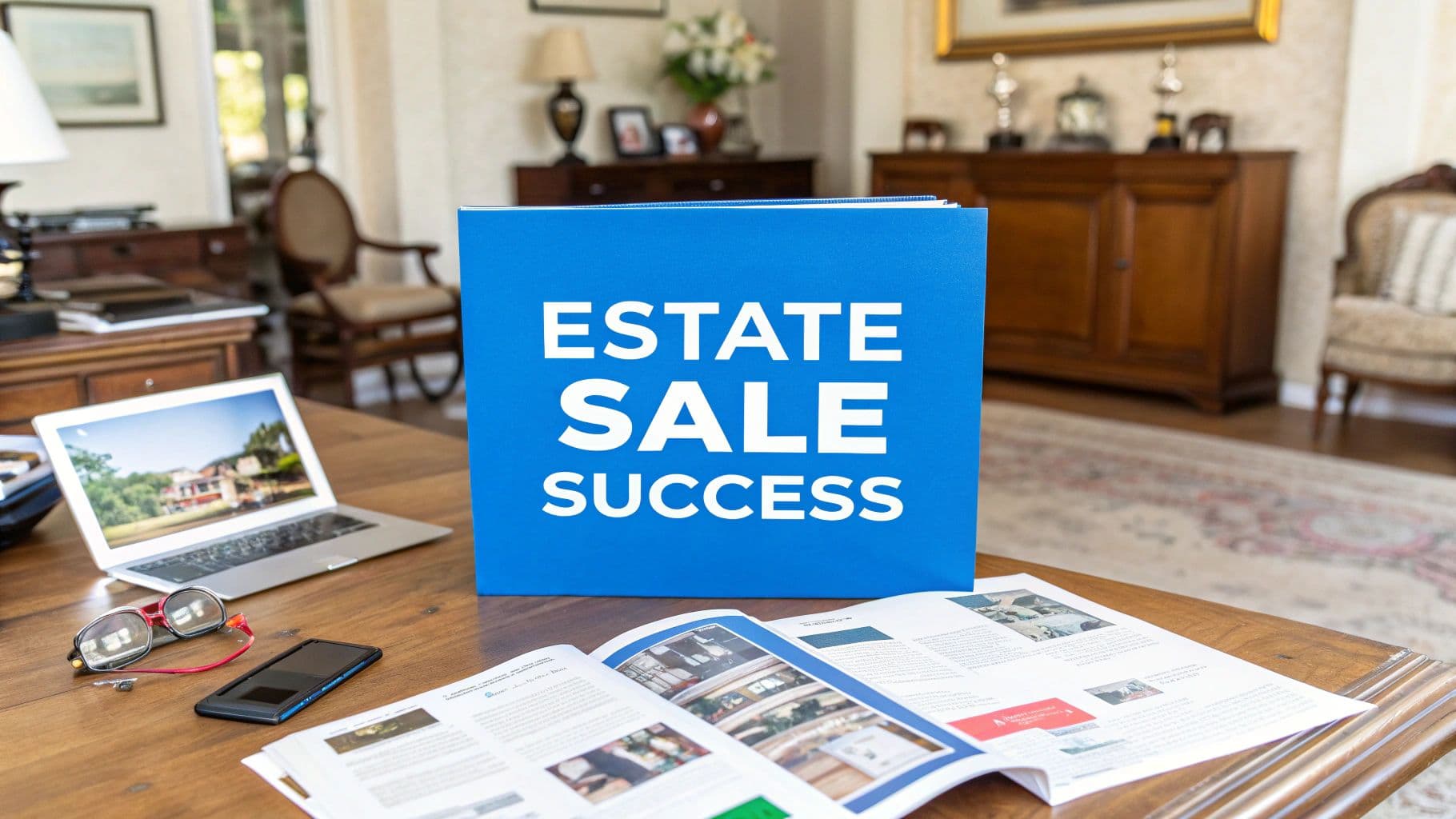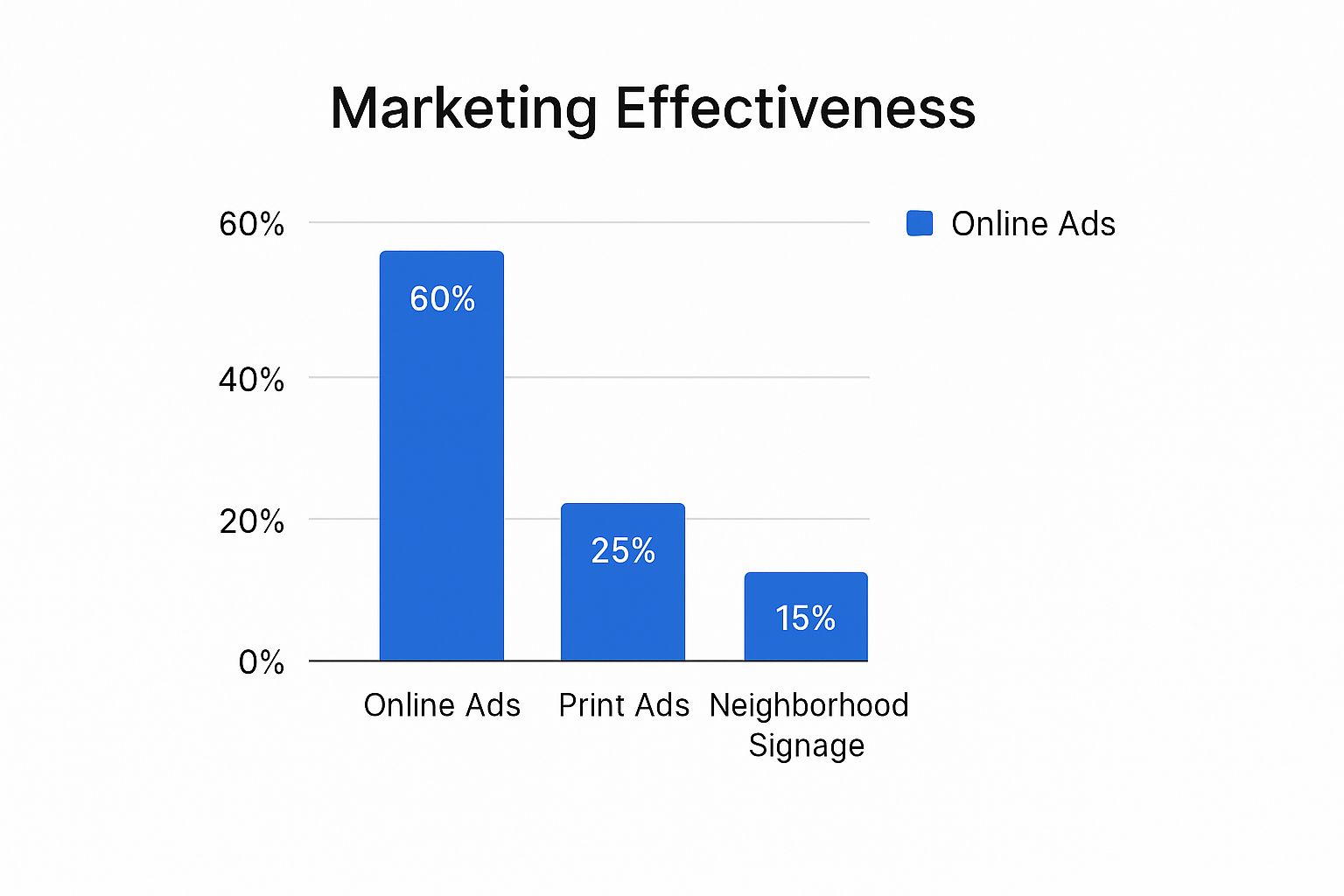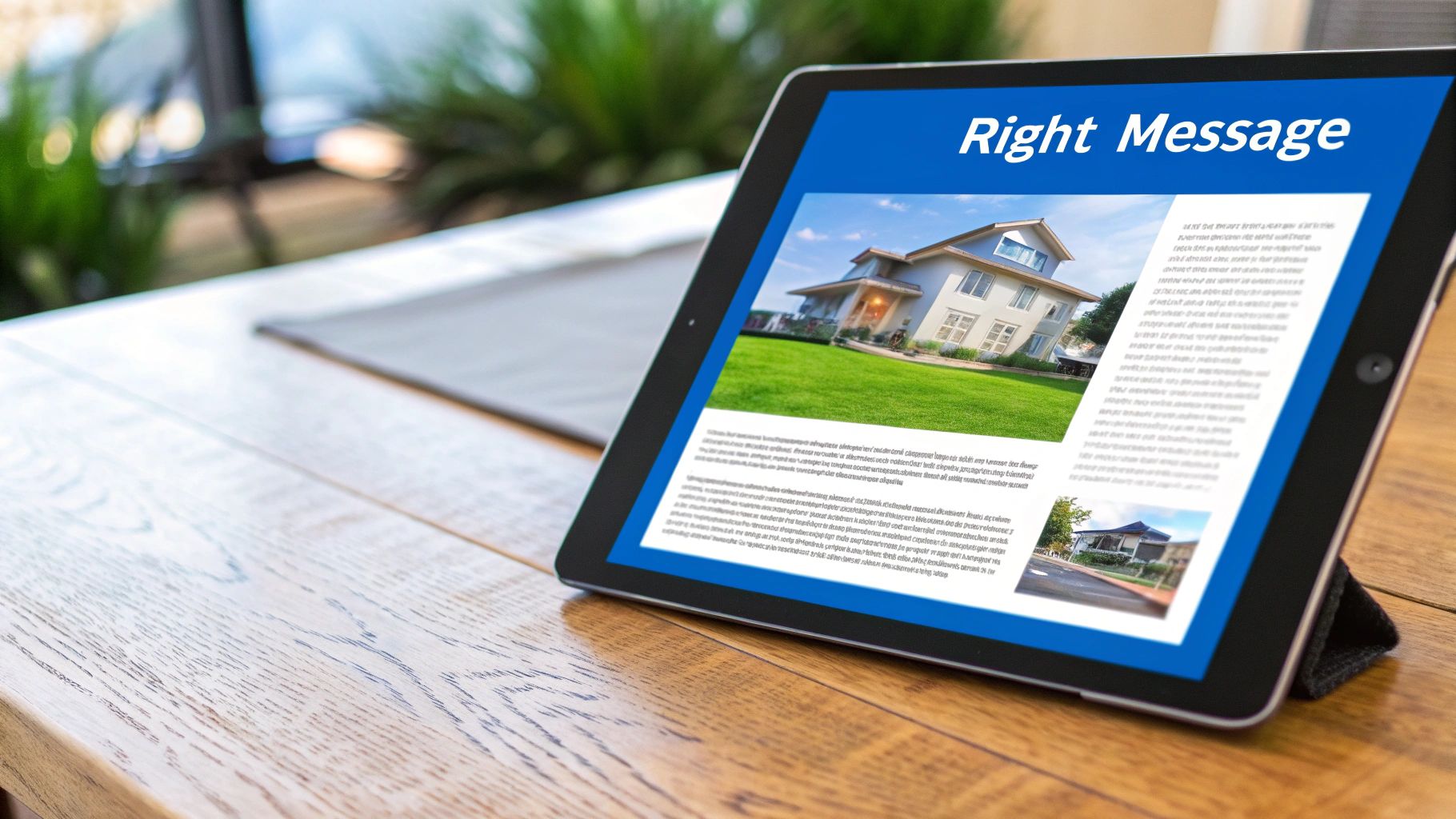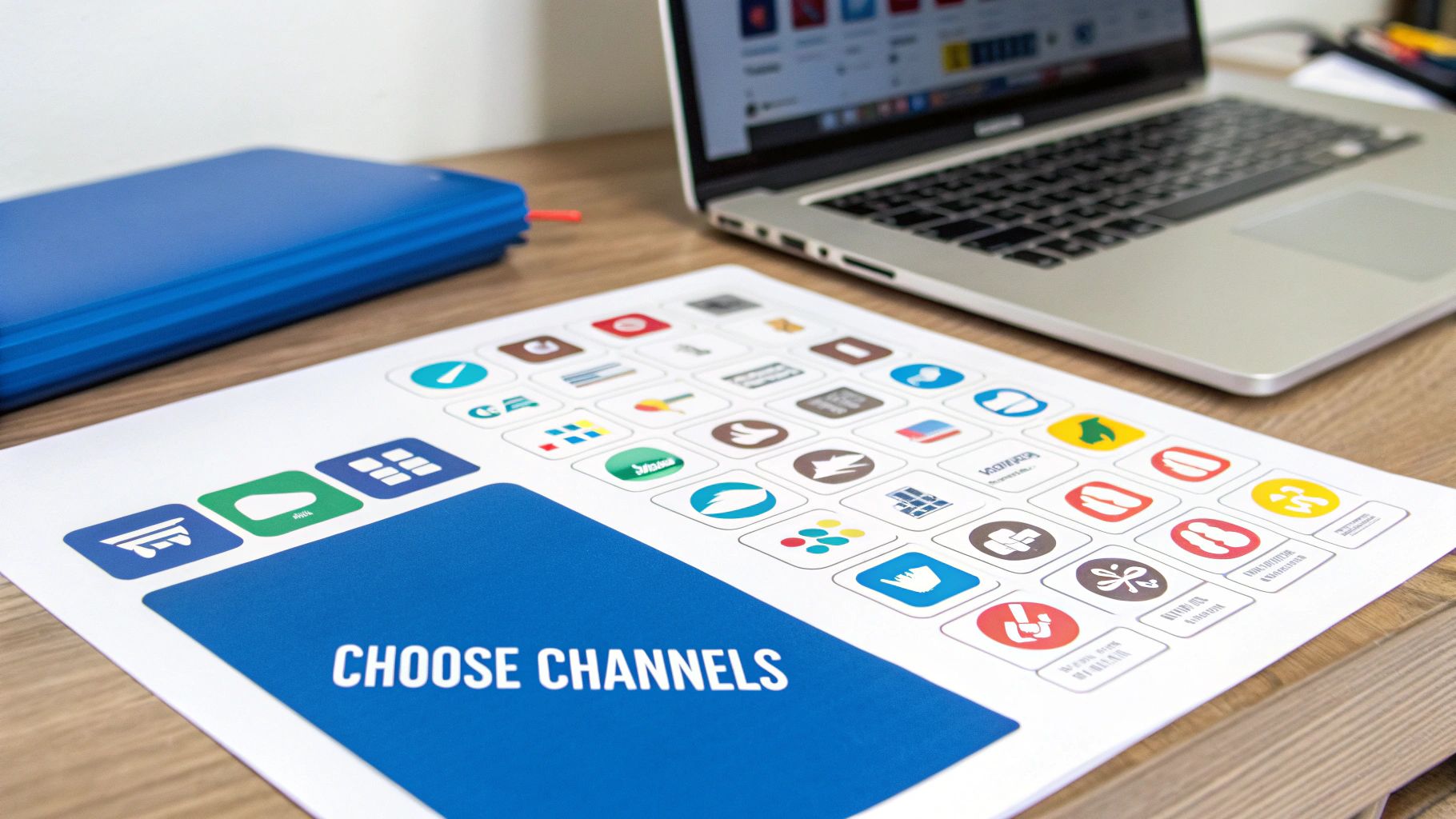Effective Estate Sale Advertising Strategies

Understanding What Makes Estate Sale Advertising Work Today
If you still picture estate sales as simple house clearances, it's time for a new perspective. Today’s sales are lively events, drawing everyone from seasoned collectors to first-time homeowners looking for unique, sustainable furniture. The secret to a successful sale is treating it like a professional retail event, and that begins with strategic estate sale advertising. Unlike a casual garage sale where the main goal is just to get rid of stuff, an estate sale is about maximizing the financial return on a lifetime of possessions. This means ditching the "yard sale" mentality for a more polished promotional strategy.
The Modern Estate Sale Shopper
The crowd at an estate sale has definitely changed. While antique dealers and resellers are still regulars, a whole new group of buyers has discovered the thrill of the hunt. These shoppers are typically looking for:
- Unique Finds: They want items with a story and character that you just can't find in a big-box store.
- Sustainability: Choosing secondhand is an eco-friendly decision that resonates with a lot of people.
- Value: Shoppers are on the lookout for quality pieces at a fair price, whether it's vintage clothing, mid-century modern furniture, or specialized tools.
Knowing who your buyers are is half the battle. Your advertising needs to tell a compelling story that connects with these different motivations, highlighting not just what you’re selling, but why it’s a must-have.
Why Professional Advertising Is Non-Negotiable
A few handwritten signs on street corners just won't cut it anymore. As estate sales have grown in popularity, so has the competition. This isn't just a local fad; the global auction industry, which includes a huge number of estate sales, is booming. In fact, projections show this sector is on a path to become a $12.35 billion industry by 2027. You can find more details about this trend on WebFX.com.
This financial growth points to one clear fact: a thought-out estate sale advertising plan is essential for success. It’s what turns an average house clearance into a high-traffic, profitable event that brings in serious buyers ready to make a purchase. The difference lies in a coordinated strategy that builds excitement and gets the word out to the right people through the right channels.
Mastering Digital Channels That Actually Drive Traffic
To get serious buyers through the door, you have to meet them where they already are: online. While traditional signs and flyers still play a role, your digital promotion is what turns a quiet sale into a can't-miss event. This isn't just about posting a listing; it's about actively using advertising tools to find specific people who are ready to buy. This is where strategic estate sale advertising truly pays off.
Choosing Your Primary Platforms
Think of your advertising budget like a set of powerful spotlights. Instead of dimly lighting up the whole town, you can aim focused beams directly at the people most likely to show up and spend. For estate sales, two platforms consistently deliver the best results: Google Ads and Facebook.
- Google Ads: This is your tool for capturing buyers who are actively searching. When someone types "estate sale near me" or "mid-century modern furniture for sale" into Google, you want your sale at the top of their results. It’s a direct line to people who are already on the hunt.
- Facebook Ads: This platform is fantastic for reaching people who aren't actively searching but have the right interests. You can target users based on their hobbies (like "antique collecting" or "vintage clothing"), location, age, and even their interactions with similar businesses. It's perfect for creating a buzz and getting your sale on their weekend agenda.
A smart estate sale advertising strategy doesn’t pit one against the other. The best approach is to use both. Dedicate some of your budget to Google to catch the active searchers and some to Facebook to inspire the passive scrollers. This two-pronged attack is a proven way to boost your foot traffic. For more ideas on blending different promotional methods, our guide on how to run an effective estate sale has some great tips.
Budgeting and Maximizing ROI
So, where should you put your money? Start by looking at what actually works. This chart shows where most organizers get the biggest bang for their buck when promoting a sale.

It's clear that online advertising is the engine that drives modern estate sales. This isn't just anecdotal; the numbers back it up. For example, Google Ads boasts an average click-through rate (CTR) of 5.07% in the search network, which is quite strong.
To help you decide where to focus your digital ad spend, here's a quick comparison of the major platforms.
Digital Advertising Platform Comparison for Estate Sales
Performance metrics and costs across major digital advertising platforms
| Platform | Average CTR | Cost Per Click | Best For | Audience Reach |
|---|---|---|---|---|
| Google Search Ads | 5.07% | $2.69 | Reaching buyers with high purchase intent (actively searching) | High-intent, localized |
| Facebook Ads | 0.90% | $1.72 | Building awareness and targeting by interest, behavior, and demographics | Broad, interest-based |
| Instagram Ads | 0.52% | $3.56 | Showcasing visually appealing items like art, fashion, and decor | Younger, visually-driven |
Table data reflects general industry averages and can vary.
The key takeaway from this data is that different platforms serve different purposes. Google is excellent for capturing immediate demand, while Facebook and Instagram are better for creating it. Given that mobile ad spending is projected to soar past $400 billion by 2025, reaching people on their phones is essential. You can dig deeper into these trends by exploring these advertising industry statistics. Putting a significant portion of your budget into a well-planned digital campaign isn't just a good idea—it's the foundation of a profitable sale.
Visual Content That Makes Items Irresistible
When it comes to estate sale advertising, your photos are your most powerful sales tool. Many potential buyers will decide whether to even show up based on the pictures you post online. Good visuals do more than just display what's for sale; they tell a story and can turn everyday items into must-have treasures. You don't need to be a professional photographer, just have a bit of a plan.

Staging and Lighting for Success
Before you even think about snapping a photo with your phone or camera, take a few minutes to stage your items. Remember, clutter is the biggest enemy of a great photo.
- Find a clean backdrop: Move any distracting junk out of the frame. A simple, neutral-colored wall or even a clear patch of lawn can make a huge difference.
- Group related items thoughtfully: Create little scenes, or "vignettes." For instance, you could arrange a few classic books next to a vintage reading lamp on an end table. This simple trick helps shoppers imagine how these items might look in their own space.
- Let natural light be your friend: The best light is soft and indirect. Try setting up near a large window, but stay out of harsh, direct sunlight that creates intense shadows. In fact, a cloudy day provides perfect, even light for outdoor photos.
Treat every single photo like it's a mini-advertisement for that item. Does it look inviting? Does it showcase the object's best qualities? Putting in this prep work will make your inventory look fantastic.
Capturing the Perfect Shot
Once your items are staged, your goal is to take a variety of photos that answer a buyer's questions before they even have a chance to ask them.
- Start wide: Take a few overview shots of each room or large collection to give people a feel for the overall size and scope of your sale.
- Move in for medium shots: Capture entire groups of items together, like a complete dining room set or a spread of power tools on a workbench.
- Get those close-ups: For valuable or particularly unique pieces, detailed close-ups are non-negotiable. Make sure to photograph any manufacturer's marks, special details, and even signs of wear. Being honest about an item's condition builds crucial trust with your buyers.
The effort you put into your photos has a massive impact. Studies have shown that listings with professionally edited photos can fetch 47% higher prices. What's more, properties advertised with high-quality images see a 1,200% increase in shares on social media, which dramatically expands your audience. If you want to dive deeper, you can find more insights in these key real estate marketing statistics. This shows that focusing on visuals isn't just for looks—it's a vital part of your estate sale advertising strategy that directly boosts your final earnings.
Tapping Into Local Networks That Bring Serious Buyers
While a good digital strategy casts a wide net, your most dedicated buyers—the ones who show up early and are ready to spend—are often found right in your own backyard. Leaning into local networks is a time-tested part of estate sale advertising that continues to produce fantastic results because it builds community trust and targets enthusiasts directly.

Building Relationships with Dealers and Collectors
Think of serious collectors and antique dealers as your VIPs. These are the people who often buy in bulk and are constantly searching for their next great find. Don't just sit back and hope they stumble upon your ad; it pays to reach out to them proactively.
A couple of practical tips:
- Make a personal connection: Stop by local antique malls or consignment shops and ask if you can leave a flyer for their vendors. Even better, collect a few business cards and send a personal email with a sneak peek of items you think they'd love.
- Join the club: Look for local collector groups on platforms like Facebook. If you have a large collection of something specific, like vintage vinyl or military memorabilia, these niche communities are absolute goldmines. A single, well-placed post in the right group can drive more qualified traffic than a dozen generic ads.
These relationships can pay off for years to come. A dealer who scores a great find at your sale is not only likely to return but will also spread the word to their network, giving you a powerful source of word-of-mouth advertising.
Beyond the Digital Sphere
Even with a strong online presence, don't overlook the power of physical media to grab local attention. People still check community boards and local publications for what's happening in their area.
- Hyper-Local Flyers: Create a clean, simple flyer that spotlights your top 3-5 "hero" items—the showstoppers. Post them (with permission, of course) on bulletin boards at community centers, grocery stores, coffee shops, and libraries. This strategy is incredibly low-cost but highly effective for neighborhood visibility.
- Strategic Signage: You absolutely cannot skip good signage. Use bold, high-contrast colors like black on yellow, with clear, large lettering and a simple arrow. Your goal is to catch the eye of someone driving by who wasn't even planning to stop at a sale.
To help you decide where to focus your efforts, here's a quick comparison of how different advertising methods stack up.
Table: Local vs. Digital Advertising Effectiveness
Comparison of reach, cost, and conversion rates between local and digital advertising methods
| Method | Reach | Cost | Conversion Rate | Best Use Case |
|---|---|---|---|---|
| Digital Ads | Broad/Targeted | Medium to High | Varies | Reaching specific demographics and active online shoppers. |
| Local Flyers | Hyper-Local | Low | High (local) | Driving foot traffic from the immediate neighborhood. |
| Dealer Outreach | Niche | Low | Very High | Selling specialty collections and high-value items quickly. |
| Yard Signs | Geo-Specific | Low | Medium | Capturing impulse traffic and guiding advertised visitors. |
Ultimately, the most successful estate sale advertising campaigns blend wide digital reach with grounded, local promotion. While digital ads bring in the volume, it’s often the local efforts that attract the most serious and high-spending buyers.
Writing Listings That Convert Browsers Into Buyers
You’ve done the hard work of staging beautiful photos and spreading the word locally. Now, your online listing is where the magic happens. The words you choose can be the difference between someone scrolling past and someone marking their calendar to attend. A great listing isn't just a simple inventory; it's your best piece of estate sale advertising, designed to build excitement and get people in the door.

Crafting a Headline That Grabs Attention
Your headline is the first thing shoppers see, and you only get one chance to make an impression. A generic title like "Estate Sale this Weekend" is easily ignored. Instead, you need to lead with what makes your sale special. Think about your most unique or desirable items and put them right in the title.
For instance, a headline like "Mid-Century Modern Collector's Estate Sale: Drexel, Eames & More" immediately signals to a specific group of buyers that your sale is a must-see. If you have a garage overflowing with equipment, something like "HUGE Tool & Woodworking Estate Sale - Packed Garage!" works wonders. These kinds of benefit-driven titles tell shoppers exactly why they should prioritize your event.
Writing Descriptions That Sell
Once your headline has them hooked, the description needs to deliver. People scan online listings, so make your information easy to find. Short paragraphs and bullet points are your best friends here.
- Start with the essentials: Get the basics out of the way first. Clearly list the address, dates, and hours of the sale. Add important notes like "Cash and Venmo accepted" or "No early birds, please." Answering these questions upfront builds trust.
- Showcase the "hero" items: After the logistics, it’s time to talk about the treasures. Mention your best items by name. Don't just say "furniture"; describe it as a "solid oak dining set with six chairs." Instead of "tools," list the "DeWalt table saw and Craftsman tool chest." Specifics help buyers visualize the goods and decide the trip is worth their time.
- Organize for clarity: Group similar items into categories. Creating sections like "Furniture," "Kitchenware," "Collectibles," and "Yard & Garden" helps shoppers quickly scan for what they’re interested in.
The language you use is just as important. Descriptive words that suggest quality and rarity, like "well-maintained," "one-of-a-kind," or "vintage collection," can spark a buyer’s excitement for finding a deal. For more help managing your inventory, you can find great info in our guide to the best estate sale software. A well-organized, descriptive listing is a key part of your estate sale advertising strategy, turning idle browsers into eager buyers.
Strategic Timing And Pricing That Maximizes Results
Great estate sale advertising is more than just clever wording and nice photos. To really pack a punch, you need to be strategic about when you advertise and how you price your items. Even the most amazing ad will fizzle out if your sale isn't set up to draw people in and make them buy.
From my experience, the sweet spot for starting your advertising push is about 7-10 days before the doors open. This gives shoppers enough time to see your ad, get excited, and plan their visit, but it isn't so far out that they forget about it.
The Art of Promotional Sequencing
You want to build a wave of excitement, not just a single splash. Start by casting a wide net with your digital ads. A Facebook ad, for instance, can start creating a general buzz in your area a week or so in advance.
Then, as you get closer to the sale date, ramp up your local, targeted efforts. This is when you hit the community forums, send out personal messages to any known collectors, and, of course, put up those crucial directional signs. This one-two punch captures both the meticulous planners who put your sale on their calendar early and the spontaneous shoppers who decide to swing by on the day of.
Don't overlook the power of seasonal timing. Spring and summer might feel like peak "garage sale season," but a well-advertised sale in the fall can be a goldmine. With fewer competing sales, your event gets more attention and often attracts more serious buyers who are ready to spend.
Pricing Strategies That Drive Sales
Think of your pricing as part of your advertising. A common guideline is the 10-20% rule for everyday used goods, pricing them at a small fraction of their original retail cost to keep things moving. But for unique, high-demand items like quality furniture, art, or collectibles, you can often aim for up to 50% of the retail value, provided they're in top-notch shape.
To create a sense of urgency and reward the most dedicated buyers, try these pricing tactics:
- Early Bird Access: Charge a small fee for an exclusive "preview hour" before you officially open. This is a huge draw for serious dealers and collectors who will gladly pay for the first pick of your best items.
- Bundle Deals: Group related items together. Think a box of vintage sci-fi paperbacks or a complete set of kitchen glassware. Selling them for a single, attractive price helps clear out smaller items much faster.
- Dynamic Markdowns: Plan your price drops from the start. A popular and effective model is offering 25% off on the second day and slashing prices to 50% off for the last few hours. When you mention these planned discounts in your initial ads, it encourages people to come back and helps ensure you sell as much as possible.
Tracking Results And Scaling Your Success
A successful estate sale advertising campaign doesn't just stop once the doors open. To turn a good sale into a great one, and to make every future sale even better, you need to understand what actually worked. The old saying, "what gets measured gets improved," is especially true here. Thankfully, you don't need fancy software—just a bit of simple tracking can give you powerful insights.
Identifying Your Key Metrics
Don't get bogged down in complicated spreadsheets. Your goal is to draw a clear line from your promotional efforts to the money in your pocket. Focusing on a few key numbers will tell you the real story of your advertising's performance.
Here are the most important things to track:
- Cost Per Visitor: How much did you spend on advertising for every person who walked through the door? Just divide your total ad spend by the number of attendees to get this figure. It shows how effective your ads are at grabbing attention.
- Average Sale Per Customer: This is your total sales divided by the number of transactions. It gives you a sense of the quality of buyers your ads attracted.
- Channel Effectiveness: This is the most direct and valuable metric. As you check people out, simply ask, "How did you hear about our sale today?" Keep a simple tally sheet with columns for "Facebook," "Yard Sign," "Website," or "Friend."
Gathering this information provides a solid foundation for your next sale. If you find out that your Facebook ads brought in 70% of your buyers, you know exactly where to put more of your budget next time.
Using Data To Scale And Improve
Once you have this data, you can stop guessing and start building a repeatable system for success. Imagine your post-sale review shows that the local community groups you posted in brought buyers with the highest average sale. For your next event, you can focus more of your energy on that exact strategy.
This approach transforms your estate sale advertising from a shot in the dark into a predictable process. For more answers to common questions, you can find a wealth of information in our ultimate estate sale FAQ guide.
By analyzing what worked, you create a feedback loop that sharpens your strategy, cuts down on wasted ad spend, and builds a loyal base of customers who know your sales are worth the trip. This is how seasoned organizers grow their business, confident that every advertising dollar is an investment, not an expense.